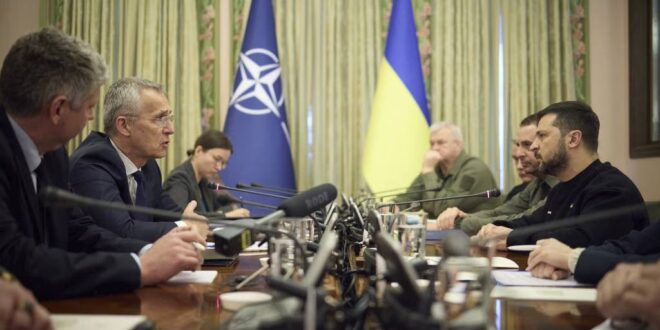NATO Secretary-General Jens Stoltenberg’s trip last week to the Ukrainian capital of Kyiv was precisely what you would expect from the head of the world’s oldest military alliance.
He toured the capital with senior Ukrainian officials, inspected some of the destroyed Russian military equipment left over from Russian President Vladimir Putin’s failed offensive in the Kyiv region a year ago and promised more military support to the Ukrainian army as it prepares for a large-scale counteroffensive in the spring or summer.
“We stood by you after Russia’s illegal annexation of Crimea in 2014,” Stoltenberg said during a news conference. “We stand by you today, in your heroic fight against the Russian invaders and in defense of your country. And we will stand by you tomorrow as you rebuild, and work toward a brighter future for the Ukrainian people.”
None of this was particularly controversial for the alliance, which has shoveled approximately $55 billion in military support to Kyiv over the last 14 months. The secretary-general, however, didn’t stop there. “Let me be clear: Ukraine’s rightful place is in the Euro-Atlantic family,” he stated matter-of-factly. “Ukraine’s rightful place is in NATO, and over time, our support will help you make this possible.”
Unfortunately for Stoltenberg, he doesn’t have any decision-making authority on this question. The decision about whether to bring Ukraine into NATO is left entirely in the hands of its 31 member states — and whether Stoltenberg and Ukrainian President Volodymyr Zelenskyy like it or not, the unanimity required to pull the trigger on Kyiv’s membership simply isn’t there. And it’s unlikely to be there anytime soon, if ever.
It didn’t take long for NATO members to weigh in. German Defense Minister Boris Pistorius tried to be diplomatic but essentially ruled out Ukrainian membership in the near or even medium term. “The door is open a crack, but this is not the time to decide now,” Pistorius said. Hungarian Prime Minister Viktor Orbán, taken aback by Stoltenberg’s comments, responded brusquely with a one-word tweet: “What?!” Even before the secretary-general made his unilateral declaration, the U.S. was lukewarm about the prospect of Ukrainian membership, with one anonymous U.S. official telling Politico’s European publication that enlarging NATO’s defense umbrella to Ukrainian territory wasn’t the priority.
This isn’t the first time NATO members have hit the brakes on Ukrainian membership. In 2008, then-U.S. President George W. Bush was a foremost proponent of beginning the accession process on Kyiv’s behalf. “Helping Ukraine move toward NATO membership is in the interest of every member in the alliance and will help advance security and freedom in this region and around the world,” Bush said days before a NATO head-of-state meeting in Bucharest, Romania.
Yet other members, France and Germany being the most significant, weren’t at all convinced about Bush’s sales pitch. The French were adamant that the balance of power in Europe would suffer if NATO permitted Ukraine to join, which after all would mean French forces now possibly being on the hook for defending Ukraine in the event of hostilities with Russia. Then-German Chancellor Angela Merkel was even more opposed, pointing out that such a move would poison strategic relations with Russia at a time when Europe’s ties with the Kremlin were beginning to sour. Merkel’s view wasn’t wrong; Ukrainian membership would be an absolute red line not only for Putin but also for the entire breadth of the Russian political establishment.
“In more than two and a half years of conversations with key Russian players, from knuckle-draggers in the dark recesses of the Kremlin to Putin’s sharpest liberal critics, I have yet to find anyone who views Ukraine in NATO as anything other than a direct challenge to Russian interests,” then-U.S. Ambassador to Russia William Burns wrote in a 2008 memo to the State Department.
Bush couldn’t overcome the objections, so NATO settled on a compromise solution: Promise that Ukraine will become a NATO member at some point. The compromise, outlined in the Bucharest Summit Declaration in 2008, was designed to kill two birds with one stone — assure Kyiv while acknowledging that the alliance was not prepared at that time to extend a security guarantee to Ukraine. But it turned out to be the worst of all worlds, with successive Ukrainian presidents strung along to believe that NATO membership was possible while Russia was led to believe that it was only a matter of time before the alliance would expand closer to its borders.
Fifteen years since the declaration was made, Ukraine’s invitation remains as open-ended today as it was back then. While Russia’s brutal assault on Ukraine has certainly pushed NATO as an institution to deepen its defense relationship with Kyiv, the Ukrainians are still on the outside of the alliance looking in. The internal politics within the alliance haven’t changed much either. If NATO hasn’t been able to reach unanimity over the last decade and a half, then it’s highly unlikely it ever will.
This reality aside, NATO continues to dangle the carrot of membership in front of Ukraine. During last year’s head-of-state summit, the alliance reiterated its original 2008 decision: Ukraine will become a member, eventually. Just don’t ask NATO officials when it will happen because it’s an open-ended issue that never gets wrapped up.
NATO calls itself a friend of Ukraine. But being a friend also means not engaging in a geopolitical form of deceit by repeatedly insisting to a nation at war that membership — and all of the defense commitments attached to it — is still technically on the table.
The Ukrainians deserve honesty, and the blunt truth is that NATO is not willing to go to war with a nuclear-armed Russia on their behalf.
 Eurasia Press & News
Eurasia Press & News



